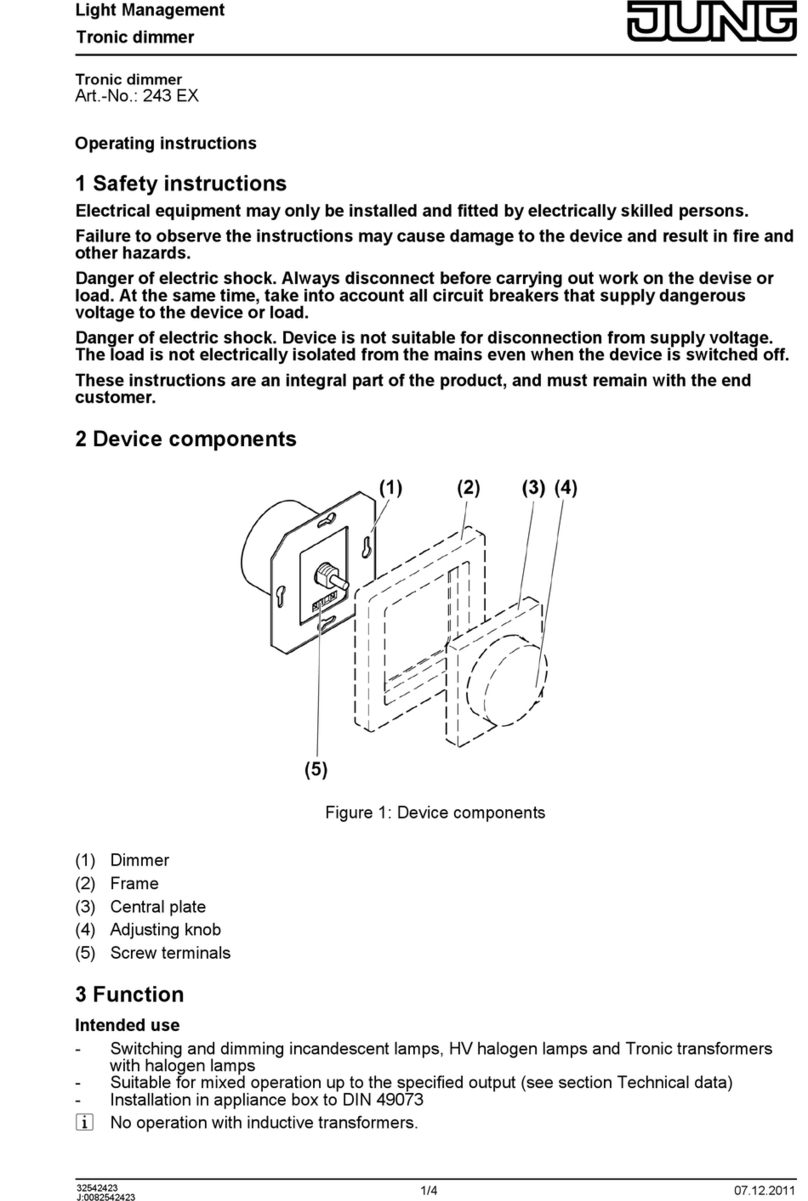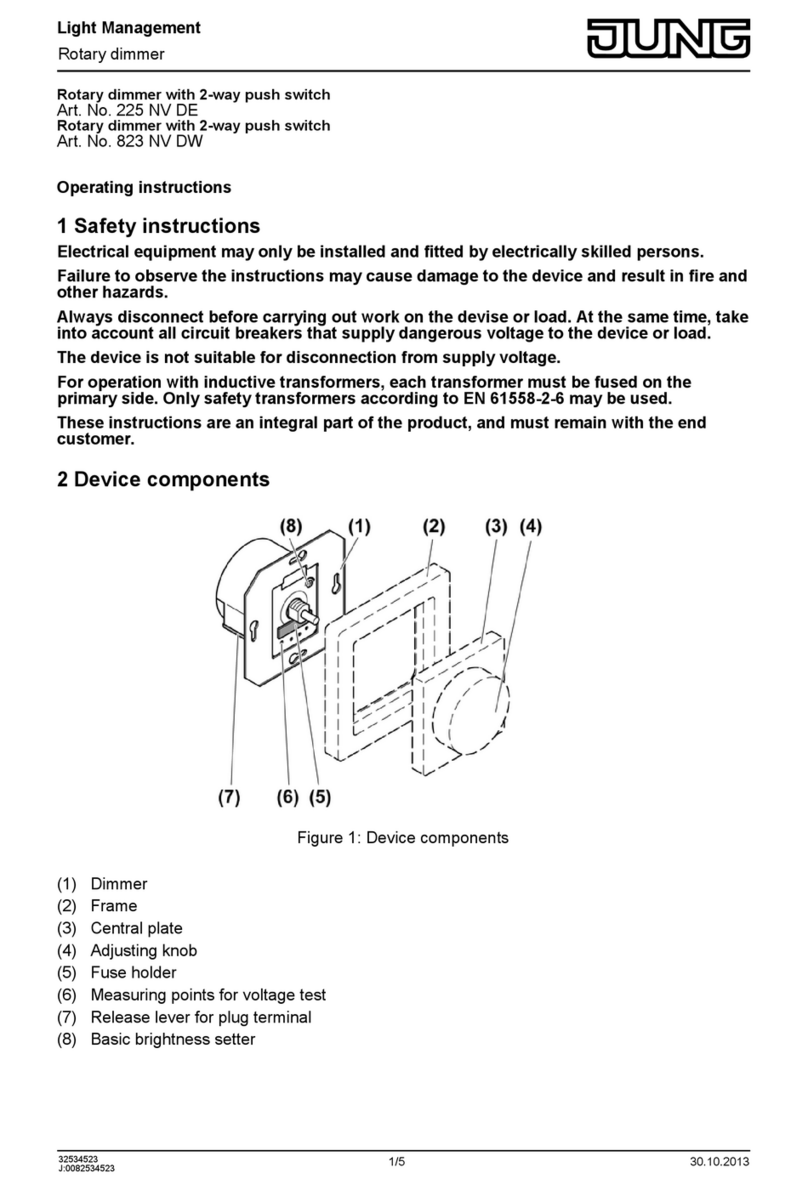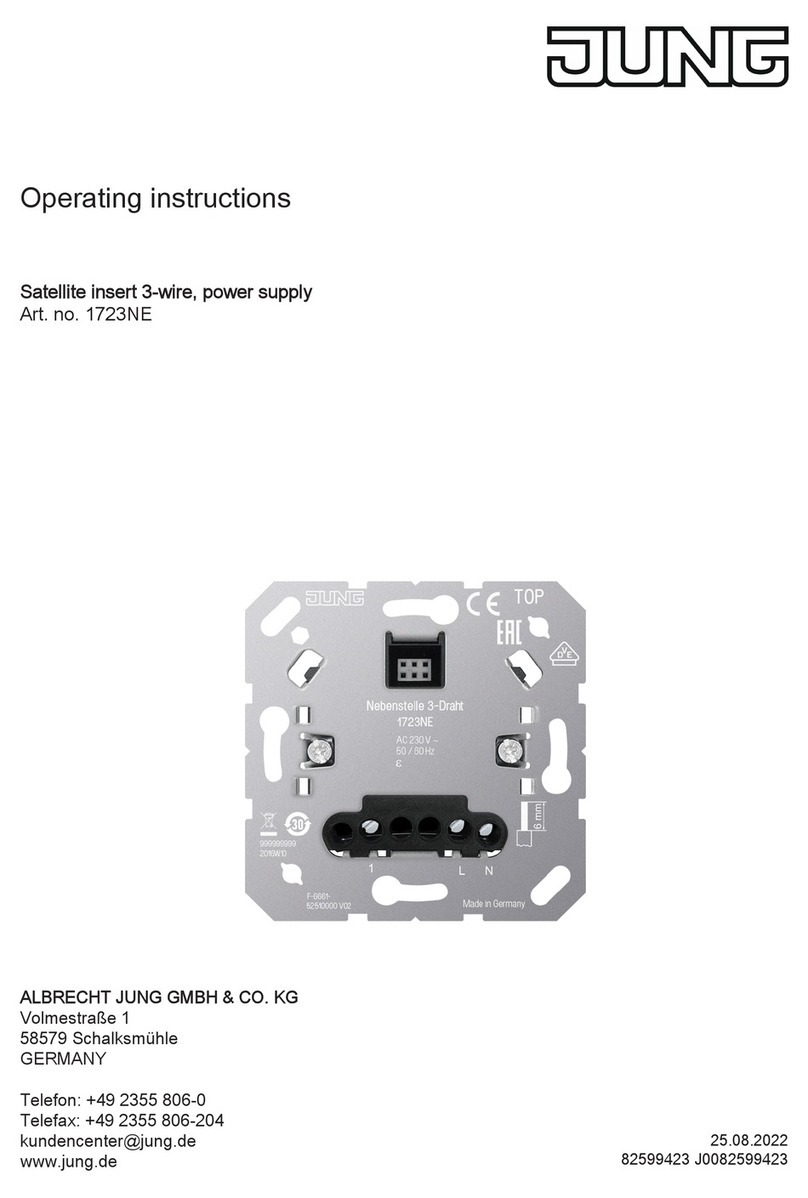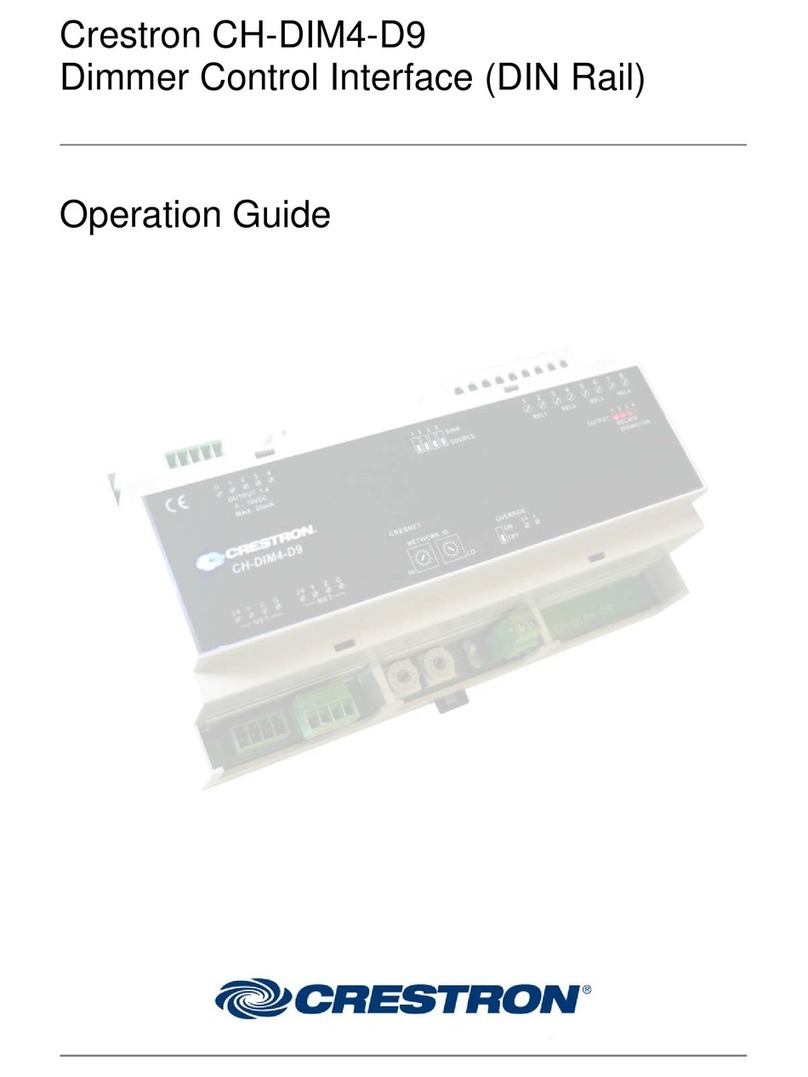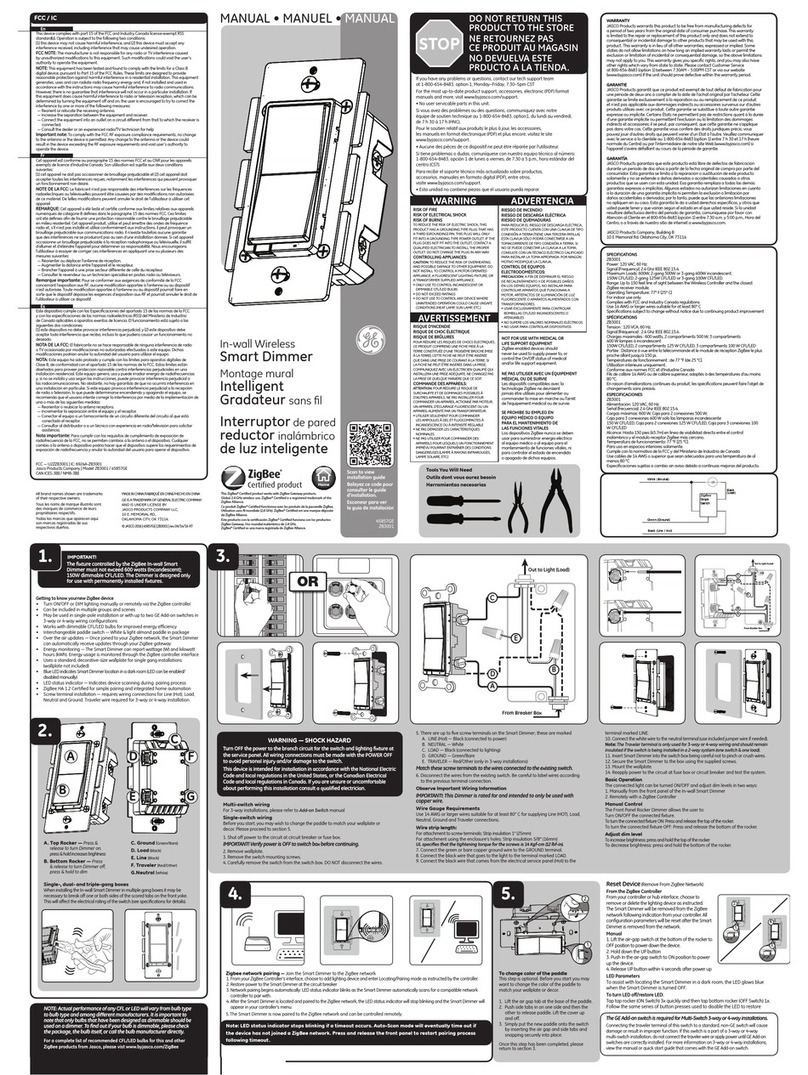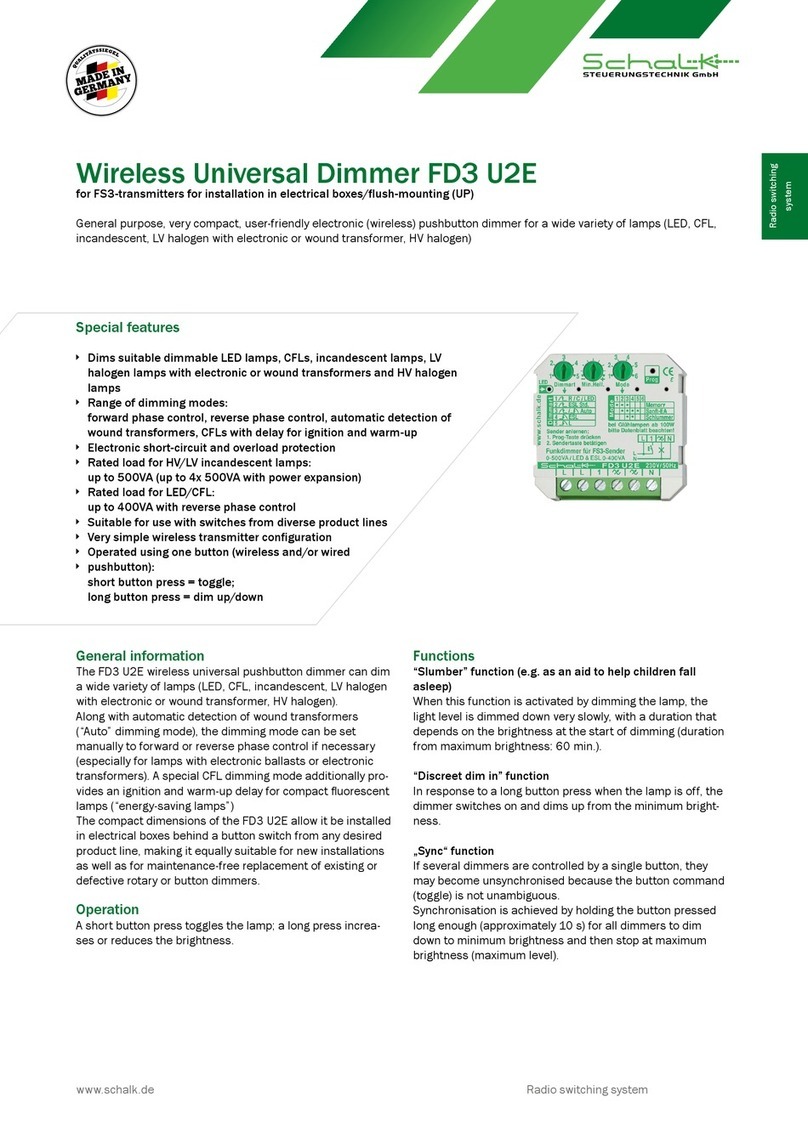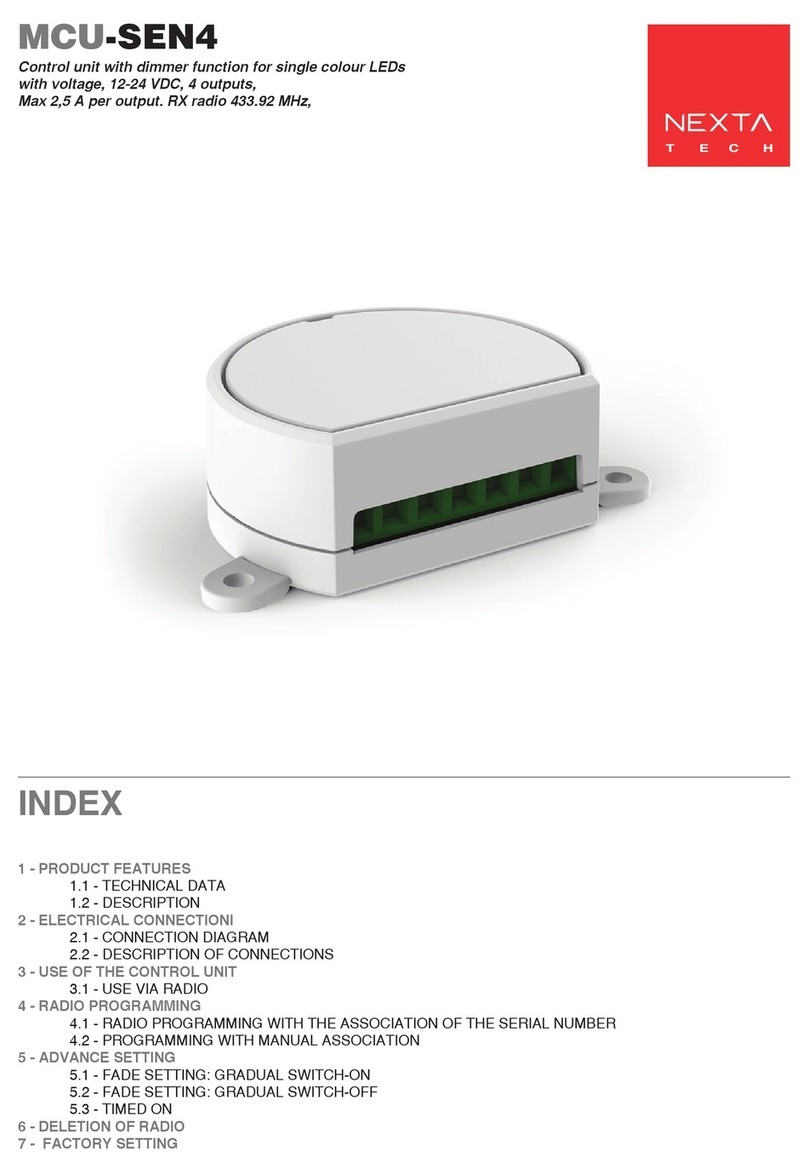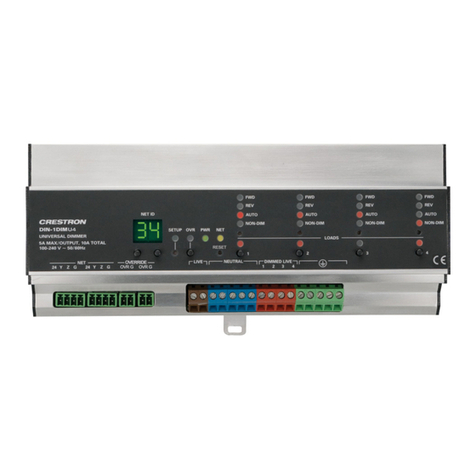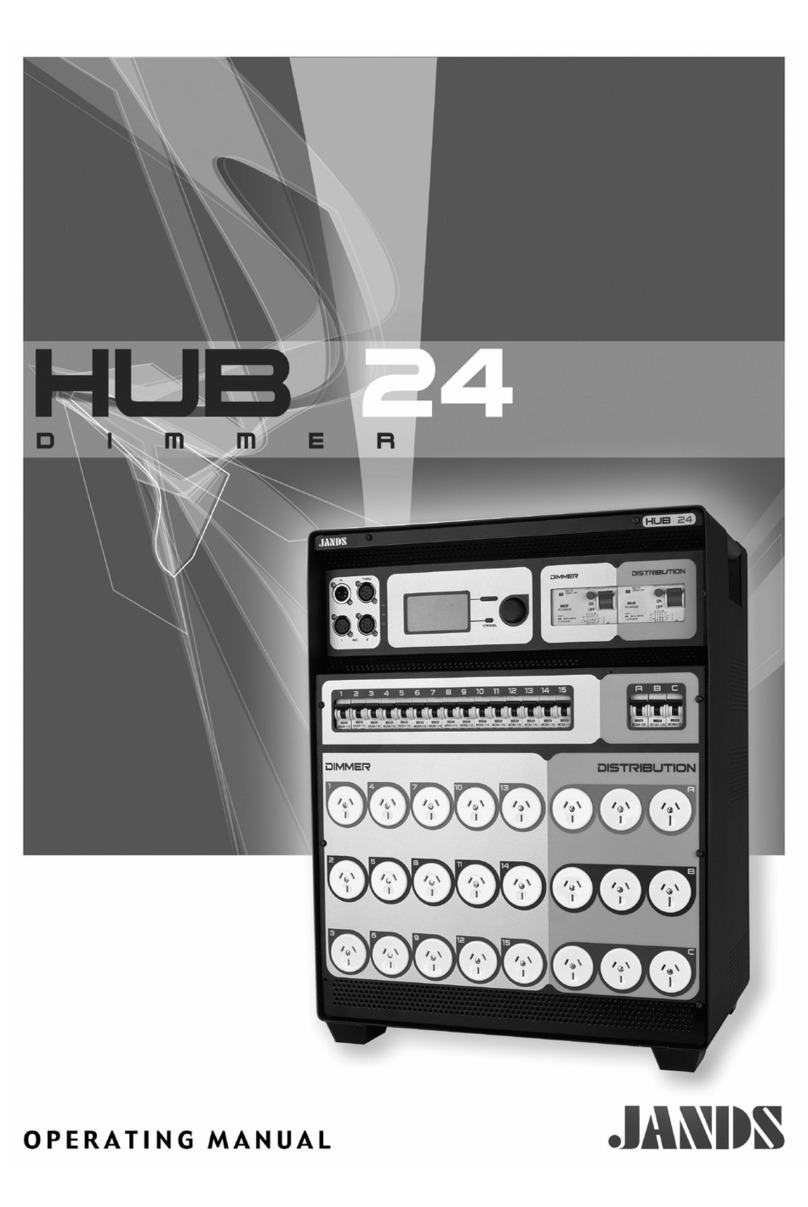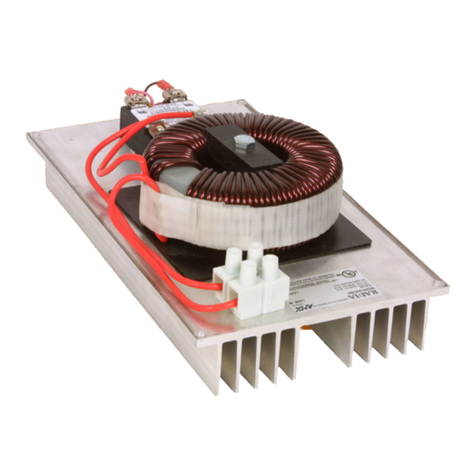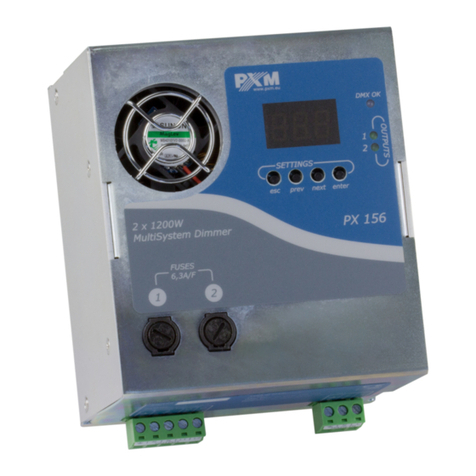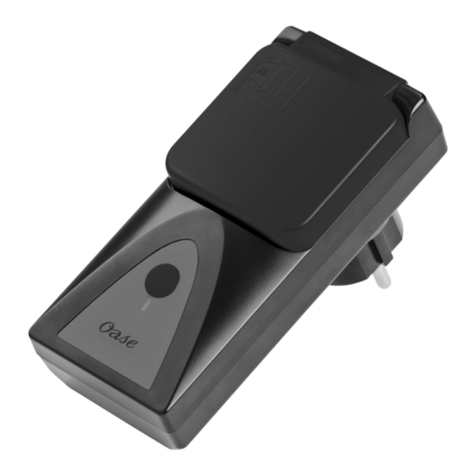Jung UDS 4 REG HE User manual

Universal dimming station 4-gang
Light Management
Universal dimming station 4-gang
Art.-No.: UDS 4 REG HE
Operating instructions
1 Safety instructions
Electrical equipment may only be installed and fitted by electrically skilled persons.
Failure to observe the instructions may cause damage to the device and result in fire and
other hazards.
Danger of electric shock. Always disconnect before carrying out work on the devise or
load. At the same time, take into account all circuit breakers that supply dangerous
voltage to the device or load.
Danger of electric shock. Device is not suitable for disconnection from supply voltage.
The load is not electrically isolated from the mains even when the device is switched off.
Do not connect any electronic lamps, e.g. switchable or dimmable compact fluorescent
lamps or LED lamps. Device can be damaged.
Fire hazard. For operation with inductive transformers, each transformer must be fused
on the primary side in accordance with the manufacturer's instructions. Only safety
transformers according to EN 61558-2-6 may be used.
These instructions are an integral part of the product, and must remain with the end
customer.
2 Device components
Figure 1: Device components
(1) Load outputs A1...A4
(2) Keypad for local control
(3) Button Prog, LED Prog
(4) Status LEDs for load outputs A1...A4
(5) Connection of control sections or control voltage
(6) Activation outputs A1'...A4' / Switching outputs E1 ON/OFF...E4 ON/OFF
(7) Connection Central ON/OFF
(8) Connection of hotel card switch
(9) Connection for mains supply
1/17
82577203
J:0082577203 31.05.2011

(10) DIN rail
Meaning of the LED in normal operation
Status LED (4) red and green light up. Initialisation of load output running
Status LED (4) green is illuminated.
Status LED (4) green off
Load output switched on
Load output switched off
Status LED (4) red flashes Control of load output via control section or
load output overtemperature
Status LEDs (4) red and green flash Short-circuit of load output
LED c Local control is switched on or
programming operation is switched on
LED ONn flashes Local control of load output, on, brighter
LED ON o flashes Local control of load output, off, darker
3 Function
Intended use
- Switching and dimming of incandescent lamps, HV halogen lamps and dimmable inductive
transformers or Tronic transformers with halogen lamps
- Suitable for mixed load up to the specified output (see section Technical data)
- Control by means of sensor modules, push-button modules, push-buttons 24 V, push-
button modules 24 V or unlit installation buttons.
- Installation in distribution boxes on DIN rail according to DIN EN 60715
i No mixed-load operation of Tronic and inductive transformers on the same load output.
Product characteristics
- Keypad for control of the dimmer station
- Control outputs A1'...A4' for activation of feedback LEDs on the control sections.
- Electronic short-circuit protection with permanent switch-off after 7 seconds at the latest
- Electronic over-temperature protection
- Switch-on brightness can be adjusted separately for each load output
- Switch-on brightness has been saved permanently.
- Bulb-preserving soft start
- Switch-off with dimming function
- Increase in output power possible through parallel switching of multiple outputs of a
dimmer station
- Power extension through power boosters (see power booster instructions)
- Connection for hotel card switch
- Central function Central ON, Central OFF
Common switching-on and switching-off of the load outputs
- Parallel switch of two dimmer stations or one dimmer station and one relay station
- Automatic setting of the dimming principle suitable for the load
Load type Electrical behaviour Dimming principle
Incandescent lamps ohmic Phase cut-off
HV halogen lamps ohmic Phase cut-off
Tronic transformers with
halogen lamps
capacitive Phase cut-off
Dimmable inductive
transformers with halogen
lamps
inductive Phase cut-on
i Flickering of the connected lamps due to undershoot of the specified minimum load or
through centralised pulses from the power stations. These are not device faults.
2/17
82577203
J:0082577203 31.05.2011
Light Management
Universal dimming station 4-gang

i Brief flickering upon load detection of ohmic loads. No operation is possible during load
detection.
Behaviour on failure and return of the mains power supply
If only the main power supply fails, then the status of the load output remain intact at first. The
dimmer station initialises when the mains power supply returns. All load outputs are switched off
after initialisation.
i During initialisation the dimmer station cannot be operated. The green and red Status
LEDs (4) of all the load outputs A1...A4 illuminate. Initialisation is complete as soon as all
the Status LEDs are off.
Behaviour on failure and return of the mains voltage on one or more load outputs
Should the mains voltage fail, the affected load outputs will switch off. When the mains voltage
returns, the affected load outputs will recalibrate themselves. During the calibration operation,
the green and red Status LEDs (4) illuminate and the load outputs cannot be operated. The load
outputs are switched off after calibration.
Function of hotel card switch
In combination with a hotel card switch, the light is switched on at switch-on brightness when
the hotel card is inserted. When the hotel card is removed, any switched-on lights remain
switched on for 1 minute and the dimmer station can be operated. When this time has elapsed,
the light is darkened within 3 minutes to minimum brightness and is then switched off. The
dimmer station can no longer be operated.
i Only load outputs to whom the central function has been assigned are switched on, whilst
all the load outputs are switched off.
4 Operation
Figure 2: Keypad local control
(4) Status LEDs for load outputs A1...A4 in normal operation
(11) Button c: Local control
(12) LED c on: Local control or programming mode active
(13) Button ON/n: Operate load output or select Master/Slave
(14) LED ON/n: Feedback LED, load output operation
(15) Button MODE : Programming mode
(16) Button OFF/o: Operate load output or select Master/Slave
(17) LED OFF/o: Feedback LED, operate load output
3/17
82577203
J:0082577203 31.05.2011
Light Management
Universal dimming station 4-gang

i If a hotel card switch is connected, the dimmer station can only be operated when the hotel
card is inserted.
Switch-on local control
o Press the c (11) button briefly.
Red status LED A1 (4) lights up, LED c (12) lights up.
The device is in local control.
Load output A1 can be controlled.
The green status LEDs (4) indicate the switching state of the load output. Status LED
illuminated: load output is switched-on, Status LED off: load output is switched-off.
Operating load outputs
Local control is switched on and the appropriate load output is selected.
Load output is switched off
o Press button ON/n (13) for less than 0.5 seconds.
Light switches to switch-on brightness.
o Press button ON/n (13) for longer than 0.5 seconds.
The light gets brighter up to maximum brightness. The LED ON/n (14) flashes for the
length of actuation
o Press button OFF/o (16) for longer than 0.5 seconds.
Light gets darker to minimum brightness. The LED OFF/o (17) flashes for the length of
actuation
o Press button OFF/o (16) for less than 0.5 seconds.
Light switches off.
o Press the c button briefly to go to the next load output.
The red status LED (4) of the next load output A2...A4 lights up.
The green status LED (4) indicate the switching state of the load output.
o Operate load output as described above.
Switching the light on with minimum brightness
Local control is switched on and the appropriate load output is selected.
Light is off.
o Press the OFF/o button for longer than 0.5 seconds.
Light switches on with minimum brightness. The LED OFF/o (14) flashes for the length of
actuation
i Alternatively, press the ON/n button for longer than 0.5 seconds. The light switches on
with minimum brightness and becomes brighter up to maximum brightness. The LED
flashes for the length of actuation.
Save switch-on brightness
Switch-on brightness can only be saved using the buttons on the dimmer station. A separate
switch-on brightness can be saved for each load output. In the state as supplied the maximum
switch-on brightness is saved.
Local control is switched on and the appropriate load output is selected.
o Set the light to the required brightness value (see above).
o Press both buttons ON/n (13) and OFF/o (16) for longer than 3 seconds.
The switch-on brightness has been saved permanently. The red status LED (4) flashes
twice as an acknowledgement.
The load output is reinitialised. The light is briefly switched off and switched on again at the
saved switch-on brightness. The red and green Status LEDs (4) illuminate.
i Saving the switch-on brightness again overwrites the old values.
4/17
82577203
J:0082577203 31.05.2011
Light Management
Universal dimming station 4-gang

Switching the load outputs centrally
All the load outputs to whom the central function has been assigned can be switched together.
As long as the Mode push-button is pressed, the system is switched from the operation of a
load output to central operation.
Local control is switched on.
o Press the Mode push-button and keep it pressed until the load outputs are switched.
The red Status LEDs (4), whose central function have been assigned to the load outputs,
illuminate.
Light is off.
o Press button ON/n (13) for less than 0.5 seconds.
Light switches to switch-on brightness.
o Press button OFF/o (16) for less than 0.5 seconds.
Light switches off.
i Central dimming is not possible.
Switching off local control
Local control is switched on.
o Keep pressing the c push-button, LED (12) c if off.
Local control is switched off.
When local control is switched off, the load outputs retain the switch position and
brightness previously set.
i After 15 s with no button being pressed, the device automatically switches local control off.
Operating using control sections
A load output is operated according to the two surface principle. One push-button, control
surface or installation button for switch-on and brighter and one push-button, control surface or
installation button for switch-off and darker. The individual load outputs are operated in the
same way as for local control. It is not possible to save switch-on brightnesses with control
sections. The red Status LED (4) of the operated load output flashes for as long as one control
section is actuated.
Central function via control sections
The functions Central ON and OFF have their own push-button, sensor surface or installation
button.
Central function has been assigned to the load outputs.
o Press the appropriate button, sensor surface or installation button for less than
0.5 seconds.
The light switches on or off at switch-on brightness.
5 Information for electrically skilled persons
5.1 Fitting and electrical connection
DANGER!
Electrical shock when live parts are touched.
Electrical shocks can be fatal.
Before carrying out work on the device or load, disengage all the
corresponding circuit breakers. Cover up live parts in the working environment.
Fitting the device
Observe the temperature range (see "Technical data"). Ensure sufficient cooling.
Output terminals up (figure 3).
5/17
82577203
J:0082577203 31.05.2011
Light Management
Universal dimming station 4-gang

i When operating multiple dimmers or power boosters in a sub-distribution, maintain a
distance of 1 module, approx. 18 mm, between the devices in order to prevent overheating.
o Mount device on DIN rail.
Connection: for operation with independent load outputs
Figure 3: Connection example: mains power supply, hotel card switch and loads
o Connect the mains power supply (figure 3).
o Connect the hotel card switch as shown in the connection example (figure 3).
i If no hotel card switch is used, then a outer conductor and the neutral conductor must be
connected directly.
o Connect loads as shown in the wiring example (figure 3).
Connection for operation with load outputs switched in parallel
Two to four load outputs can be switched in parallel for power extension. A load output is then
assigned to the Master of the additional load outputs as a Slave.
o Connect mains supply (9) as shown in the connection example (figure 4)
o Connect the hotel card switch as shown in the connection example (figure 4).
i If no hotel card switch is used, then a outer conductor and the neutral conductor must be
connected directly.
All load outputs are switched off.
Load outputs are not yet switched on.
DANGER!
Electrical shock when live parts are touched.
Electrical shocks can be fatal.
Use only insulated tools when working on the device! Cover up live parts in the
working environment.
o Switch on mains voltage.
All the LEDs illuminate briefly.
LED Prog lights up red.
o Insert the hotel card in the hotel card switch.
LED Prog lights up green.
o Press the push-button Prog (3) until LED Prog (3) flashes alternately in red and green.
6/17
82577203
J:0082577203 31.05.2011
Light Management
Universal dimming station 4-gang

Programming mode is switched on. In this operating mode, the push-buttons of the button
panel (2) are assigned to the load outputs according to the table.
Load output A1 c
Load output A2 MODE
Load output A3 ON/n
Load output A4 OFF/o
In general, any load output can be specified as the Master. The first selected load output is the
Master to which any other load outputs are assigned as Slaves. A maximum of two Masters
may be specified. In this case, a Master is first specified with a Slave and then the steps
repeated for the second Master.
o Press the push-button of a load output and keep it pressed during Slave assignment.
The green status LED (4) of the load output lights up. The load output is specified as the
Master.
o Briefly press the push-button of another load output.
The load output is assigned to the Master as a Slave. The red status LED (4) of the load
output lights up.
i To delete the assignment, press the push-button of the Slave again. The red status LED
(4) goes out.
o If necessary, briefly press the push-button of another free load output.
The load output is assigned to the Master as a Slave. The red status LED of the load
output lights up.
o Release the push-button of the Master.
The green Status LED of the Master illuminates.
Two further load outputs are available.
o Optionally, carry out the second Master-Slave assignment as described above.
o Press the Prog push-button until all the LEDs illuminate briefly.
The red Status LEDs illuminate briefly.
Assignments are saved. The dimmer station reinitialises itself.
i During initialisation, firstly the green and red Status LEDs (4) of all the load outputs A1...A4
illuminate. Initialisation is complete as soon as all the Status LEDs are off.
o Switch off mains voltage.
7/17
82577203
J:0082577203 31.05.2011
Light Management
Universal dimming station 4-gang

Connecting loads to load outputs switched in parallel
Figure 4: Connection example of load outputs switched in parallel
CAUTION!
Risk of destruction of load outputs switched in parallel if the device is set
incorrectly.
Dimmer and loads may be destroyed.
Specify the Master and the Slave before connecting the loads to the load
outputs.
CAUTION!
400 V are shorted when outputs switched in parallel are connected to different
outer conductors.
The device will be destroyed.
Always connect outputs switched in parallel to the same outer conductor.
CAUTION!
When connecting power extensions to load outputs switched in parallel, there
is no guarantee that the dimmer sets the dimming principle suitable for the
load.
Dimmer, power extension and load may be destroyed.
Do not connect any power extensions to load outputs switched in parallel.
Only subject load outputs switched in parallel to up to 80%.
The minimum load of parallel switching of load outputs is 150 W.
Example
Load output Connected load
A1 20...150 W/VA
A1+A2 150...240 W/VA
A1+A2+A3 150...360 W/VA
A1+A2+A3+A4 150...480 W/VA
o Connect loads as shown in the connection example.
8/17
82577203
J:0082577203 31.05.2011
Light Management
Universal dimming station 4-gang

Connecting a control section
Operation take place using the devices listed under Accessories.
In case of operation with sensor modules (19) or push-button modules (19) do not connect any
other control sections such as push-buttons (24 V) (18), push-button modules 24 V (18) and
unlit installation buttons (20), to the dimmer station.
Observe technical data, especially the maximum number of sensor modules and push-button
modules, load capacity of the activation outputs and switching inputs.
o Connect the control section as shown in connection example (figure 5), (figure 6) or
(figure 7).
Figure 5: Connection example of push-button 24 V, 4x, push-button module 24 V, 4x
Figure 6: Connection example for sensor module or push-button module
9/17
82577203
J:0082577203 31.05.2011
Light Management
Universal dimming station 4-gang

Figure 7: Wiring example for unlit installation button
Operation of two dimmer stations with a sensor module or push-button module
Sensor modules or push-button modules can operate two dimmer stations together. This
requires connection of both dimmer stations in parallel. To do this, the sensor modules must
have at least release version R2. The device address of a dimmer station must be changed
(see "Setting the device address")
Figure 8: Connection example for one sensor module or push-button module to two dimmer
stations
o Connect the sensor module or push-button module to two dimmer stations according to the
connection example (figure 8).
i Connect the power supply of the dimmer stations to the same outer conductors.
i Even dimmer stations switched in parallel may only have four sensor modules or push-
button modules connected to them.
Operation of multiple dimmer stations with a push-button 24 V or push-button module 24
V
In operation with push-button 24 V or push-button module 24 V, they can be connected to up to
four dimmer stations. To do this, the negative poles of the individual dimmer stations have to be
connected to each other. It is possible, for example to switch load outputs of several dimmer
10/17
82577203
J:0082577203 31.05.2011
Light Management
Universal dimming station 4-gang

stations with a single push-button 24 V (figure 9), or to implement central control of several
dimmer stations (figure 10).
Connection example for one push-button 24 V to two dimmer stations. Here Kanal 1 and Kanal
2 of the push-button 24 V switches load output A1 of the right-hand dimmer station, and Kanal
3 and Kanal 4 switches load output A1 of the left-hand dimmer station.
Figure 9: Connection example for one push-button 24 V or push-button module 24 V to two
dimmer stations.
Connection example central function. Here Kanal 7 of the push-button sensor Central ON and
Kanal 8 switches Central OFF.
Figure 10: Wiring example for Central ON, Central OFF
o Connect push-button sensor 24 V as shown in the wiring example (figure 9) or (figure 10).
i The feedback LEDs of the push-button 24 V are only connected to the activation outputs of
one dimmer station. This dimmer station then indicates the status of the load outputs,
standing in for both dimmer stations.
i In like manner, installation buttons can also be used.
11/17
82577203
J:0082577203 31.05.2011
Light Management
Universal dimming station 4-gang

5.2 Commissioning
DANGER!
Electrical shock when live parts are touched.
Electrical shocks can be fatal.
Use only insulated tools when working on the device! Cover up live parts in the
working environment.
Overview of programming and setting modes
Press the Mode button for approx. 3 seconds. Programming mode for minimum brightness
and central function
Press the push-buttons ON/n and OFF/o
simultaneously for approx. 3 seconds.
Setting the device address and status
messages
Press Mode and Prog buttons simultaneously
for approx. 3 seconds
Parallel switching of load outputs (see chapter
Mounting and Electrical Connection)
Setting the minimum brightness of the load outputs A1...A4
The use of different lamps or power extensions means that different minimum brightnesses may
occur. To compensate for these, the minimum brightness of the individual load outputs can be
set.
The dimmer station is mounted and connected properly.
o Switch on mains voltage.
o All the LEDs illuminate briefly.
o Press MODE button (15) for approx. 3 seconds.
LED c (12) lights up, programming mode is switched on.
Red and green status LEDs (4) of load output A1 are flashing.
The light of the load output A1...A4 is set to the saved minimum brightness.
o If necessary, press the Mode button to switch to the next load output.
The green and red status LEDs (4) of the next load output flash.
o Press button Prog (3) briefly.
The load output is reinitialised. The procedure is completed when the green and red Status
LED (4) of the load output lights up.
o Use the push-buttons ON/n (13) and OFF/o (16) to set the minimum brightness.
o Press button Prog (3) briefly.
The minimum brightness for the load output is saved. The load output is reinitialised.
On completion of initialisation, the green and red status LEDs (4) of the next load output
flash.
i When the minimum brightness of the last load output has been saved, the switch to
configuring the central function takes place automatically. The green or red status LED (4)
of load output A1 illuminates. If you do not wish to change the central function, keep on
pressing the push-button Mode briefly until the LED c (12) goes out.
Configuring the central function
i In the state as supplied the central function is assigned to all of the load outputs.
The LEDs of the individual load outputs indicate whether the central function is active for that
output.
Red LED lights up = central function not assigned
Green LED lights up = central function assigned
o Press MODE button (15) for approx. 3 seconds.
LED c (12) lights up, programming mode is switched on.
Red and green status LEDs (4) of load output A1 are flashing.
12/17
82577203
J:0082577203 31.05.2011
Light Management
Universal dimming station 4-gang

The light of the load output A1...A4 is set to the minimum brightness.
o Press the Mode push-button until the red or green LED of load output A1 illuminates.
o To assign the central function for load output A1, press the ON/n (12) button.
The green status LED (4) of load output A1 flashes. The central function has been
assigned.
o To remove the central function for load output A1, press the OFF/o (16) button.
The red status LED (4) of load output A1 flashes. The central function has been removed.
o Press MODE button briefly.
The central function for the next load output can be assigned.
Exit programming mode
o Press the Mode button (15) as many times as necessary until LED c (12) goes out.
The green status LED (4) indicate the switching states of the load outputs A1...A4.
i After 15 seconds without a button-press the programming mode is automatically
terminated.
Setting the device address
If two dimmer stations are connected in parallel, the device address of a dimmer station has to
be reprogrammed before the sensor modules or push-button modules are commissioned. In the
state as supplied each dimmer station has the device address 1.
Sensor modules or push-button modules are connected.
o Press ON/n (13) and OFF/o (16) buttons simultaneously for approx. 3 seconds.
LED c (12) lights up.
The green status LED of output A1 flashes. This means that the device address 1 is set.
o Press the ON/n (13) or OFF/o (16) button briefly.
The green status LED of output A2 flashes. Device address 2 has been set.
o Press the buttons ON/n (13) and OFF/o (16) again simultaneously for approx. 3 seconds
or wait for 15 seconds.
The dimmer station switches to normal operation.
The dimmer station has the device address 2.
i To set device address 1 again, repeat the above steps.
Switching on status message for sensor modules and push-button modules.
In operation with sensor modules, a status message has to be transmitted regularly. In the state
as supplied this status message is switched off.
o Press ON/n (13) and OFF/o (16) buttons simultaneously for approx. 3 seconds.
LED c (12) lights up.
The green status LED (4) of load output A1 or A2 flashes.
o Press MODE button briefly.
All green status LEDs (4) of the load outputs A1...A4 flash briefly.
The regular status message is switched on.
o Press the buttons ON/n (13) and OFF/o (16) again simultaneously for approx. 3 seconds
or wait for 15 seconds.
The dimmer station switches to normal operation.
i The regular status message is switched off in the same way as it is switched on. All the red
status LEDs (4) of the load outputs A1...A4 flash briefly as acknowledgment.
Cloning sensor modules or push-button modules.
"Cloning" is used to transfer the button assignments of a module to other modules. Only
identical devices can be cloned - sensor module to sensor module or push-button module to
push-button module. Operation of the dimmer station is not possible during cloning mode.
Several sensor modules or push-button modules are connected to the dimmer station.
13/17
82577203
J:0082577203 31.05.2011
Light Management
Universal dimming station 4-gang

Button assignments have been made on a module.
o Press the MODE and Prog buttons simultaneously until the c (12), ON/n (13) and OFF/
o (17) LED flash.
The dimmer station and sensor modules or push-button modules are in cloning operation.
A C flashes on the sensor modules, and all the red LEDs are flashing on the push-button
modules.
o Within approx. 2 minutes, press a button on the module that is to be cloned.
A + flashes on the sensor module, and all the red LEDs are flashing rapidly on the push-
button module.
A C continues to flash on the sensor modules, and all the red LEDs continue to flash on the
push-button modules.
o Within approx. 2 minutes, press a push-button on another sensor module or push-button
module.
Instead of a C, a - flashes for approx. 2 seconds, and all the red LEDs flash rapidly on the
push-button module.
The module has adopted the button assignments, and cloning mode is terminated.
o Repeat the steps described above for additional modules.
i Cloning mode cannot be terminated manually. To abort cloning mode once it has started,
wait 2 minutes without pressing any sensor module or push-button module.
i If cloning mode is activated on the dimmer station when there are no sensor modules or
push-button modules connected, cloning mode will be terminated automatically after
3 minutes.
6 Appendix
6.1 Technical data
Rated voltage AC 230 V ~
Mains frequency 50 / 60 Hz
Power loss max. 20 W
Standby power max. 2 W
Terminals -, +
Control voltage DC 24 V SELV
Current carrying capacity Σ 80 mA
Total length of control cable max. 100 m
Number of sensor modules 4
Number of push-button modules 4
Number of push-button sensors 24V / push-
button sensor modules 24 V
Type-dependent
Switching inputs E1 ON/OFF...E4 ON/OFF
Control voltage DC 24 V SELV
Resistance Ri 200 kΩ
Activation outputs A1'...A8'
Control voltage DC 24 V SELV
Current carrying capacity 10 mA
Resistance Ra 330 Ω
Connection
Rated voltage/load outputs/hotel card switch
Single stranded 0.5 ... 4 mm²
finely stranded with conductor sleeve 0.14 ... 2.5 mm²
finely stranded without conductor sleeve 0.34 ... 4 mm²
Activation outputs/switching outputs/control sections
Single stranded 1.5 mm²
finely stranded with conductor sleeve 0.75 mm²
finely stranded without conductor sleeve 1.0 mm²
Load outputs A1...A4
Contact type ε
Total length power cable per channel 100 m
Connected load per load output
14/17
82577203
J:0082577203 31.05.2011
Light Management
Universal dimming station 4-gang

i Power specifications including transformer power dissipation.
i Operate inductive transformers with at least 85% nominal load.
i For ohmic-inductive mixed load, maximum 50% proportion of ohmic load. Otherwise
incorrect calibration of the dimmer may result.
i Only subject load outputs switched in parallel to up to 80%.
i The minimum load of parallel switching of load outputs is 150 W.
Incandescent lamps 20 ... 150 W
HV halogen lamps 20 ... 150 W
Tronic transformers 20 ... 150 W
Inductive transformers 20 ... 150 VA
ohmic-capacitive 20 ... 150 W
Ohmic-inductive 20 ... 150 VA
capacitive-inductive not permitted
Power reduction
per 5°C in excess of 45°C -15 %
Power boosters See power booster instructions
Fitting width 144 mm / 8 modules
The symbols used to label the dimmer load shows the load type that can be
connected to a dimmer and the electric behaviour of a load: R = ohmic, L = inductive,
C = capacitive
6.2 Troubleshooting
Load output switches the load off briefly and then on again.
Cause: short-circuit protection has tripped but now there is no longer a fault.
Load output switches the load off and cannot be switched on again.
Cause 1: short-circuit protection has tripped, the red and green Status LEDs (4) of the
appropriate load output flash.
Eliminate short-circuit.
Switch on load output again.
i Short-circuit protection is not based on a conventional fuse, no metallic separation of the
operational current.
Cause 2: overtemperature protection has tripped, the red Status LED (4) of the appropriate load
output flashes.
Load output is defective.
Load output switches the load off and can only be switched on again after a certain time.
Cause: overtemperature protection has tripped due to an overload or an excessively high
ambient temperature, the red Status LED (4) of the appropriate load output flashes.
Check the installation situation.
Reduce the connected load.
No operation is possible.
Cause 1: there is no hotel card in the hotel card switch, LED Prog is red.
Insert the hotel card, the Prog LED turns green.
Cause 2: no hotel card switch is connected, LED Prog is red
Connect the hotel card switch or outer conductor and neutral conductor to the terminals for
the hotel card switch, LED Prog turns green.
No control is possible via control sections.
Cause 1: local control is switched on.
Switch off local control (see chapter 4. Operation).
Cause 2: programming mode is switched on.
Switch off programming mode (see Commissioning)
15/17
82577203
J:0082577203 31.05.2011
Light Management
Universal dimming station 4-gang

Load output cannot be operated.
Cause 1: load output is not ready for operation.
Check installation.
Check load.
Cause 2: the load output is assigned to a Master as a Slave.
Check the installation, adjust the dimmer station appropriately (see the chapter Mounting).
Cause 3: overtemperature protection has tripped, the red Status LED (4) of the appropriate load
output flashes.
Let the load output cool down. When the load output has cooled down sufficient, it switches
on again.
Load outputs switched in parallel cannot be operated.
One of the load outputs is not ready for operation.
Check installation.
Load output does not react to central controller
Cause: no central controller is assigned to the load output.
Assign central controller (see Commissioning).
Load output does not switch on using the hotel card switch.
Cause: no central controller is assigned to the load output.
Assign central controller (see Commissioning).
6.3 Accessories
Relay station universal, 8-gang Art.-No.: RS 8 REG HE
Sensor module 8-gang Art.-No.: SM 1608
Push-button module Art.-No.: 4008 TSM
Push-button sensor 24 V AC/DC, 2-gang Art.-No.: ..2224..
Push-button sensor 24 V AC/DC, 4-gang Art.-No.: ..2248..
Push-button module 24 V AC/DC, 1-gang Art.-No.: 4212 TSM
Push-button module 24 V AC/DC, 2-gang Art.-No.: 4224 TSM
Push-button module 24 V AC/DC, 3-gang Art.-No.: 4236 TSM
Push-button module 24 V AC/DC, 4-gang Art.-No.: 4248 TSM
16/17
82577203
J:0082577203 31.05.2011
Light Management
Universal dimming station 4-gang

6.4 Warranty
We reserve the right to make technical and formal changes to the product in the interest of
technical progress.
We provide a warranty as provided for by law.
Please send the unit postage-free with a description of the defect to our central customer
service office:
ALBRECHT JUNG GMBH & CO. KG
Service Center
Kupferstr. 17-19
D-44532 Lünen
Service-Line: +49 (0) 23 55 . 80 65 51
Telefax: +49 (0) 23 55 . 80 61 89
General equipment
Service-Line: +49 (0) 23 55 . 80 65 55
Telefax: +49 (0) 23 55 . 80 62 55
KNX equipment
Service-Line: +49 (0) 23 55 . 80 65 56
Telefax: +49 (0) 23 55 . 80 62 55
The Πsymbol is a free trade symbol, which is solely intended for the authorities and does not
guarantee any properties.
ALBRECHT JUNG GMBH & CO. KG
Volmestraße 1
D-58579 Schalksmühle
Telefon: +49.23 55.8 06-0
Telefax: +49.23 55.8 06-1 89
E-mail: [email protected]
Internet: www.jung.de
www.jung-katalog.de
17/17
82577203
J:0082577203 31.05.2011
Light Management
Universal dimming station 4-gang
Table of contents
Other Jung Dimmer manuals
Popular Dimmer manuals by other brands

urmet domus
urmet domus Yokis MTV500ERP manual
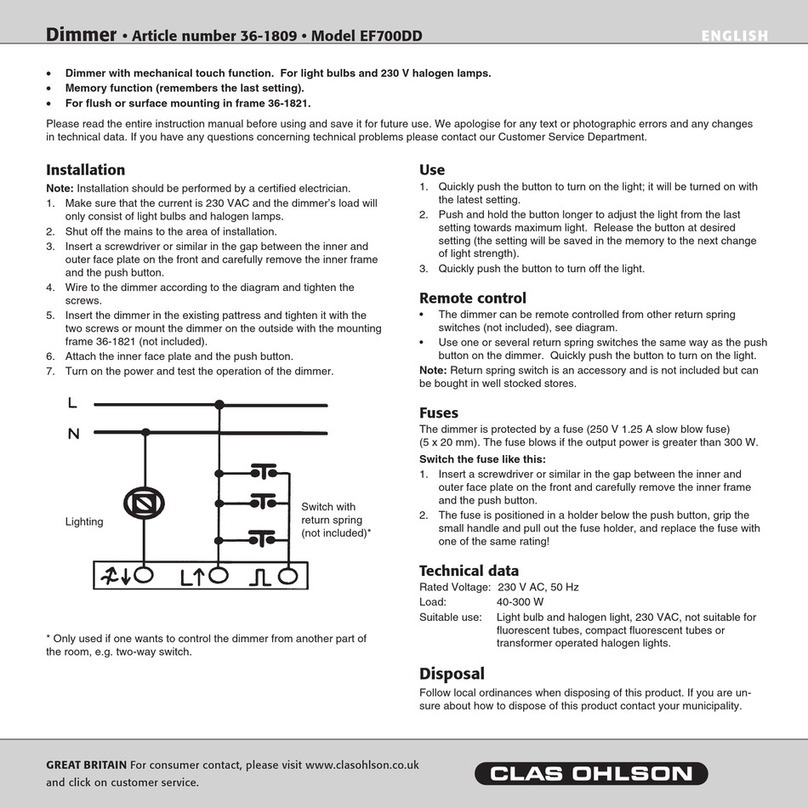
Clas Ohlson
Clas Ohlson EF700DD manual
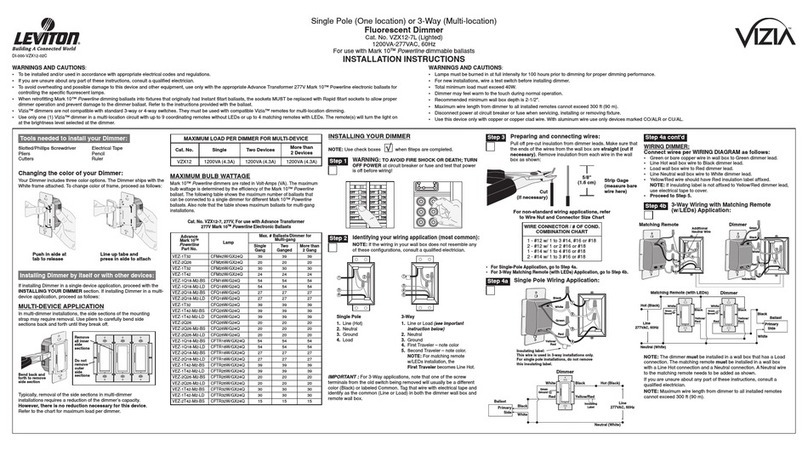
Leviton
Leviton VZX12-7L installation instructions
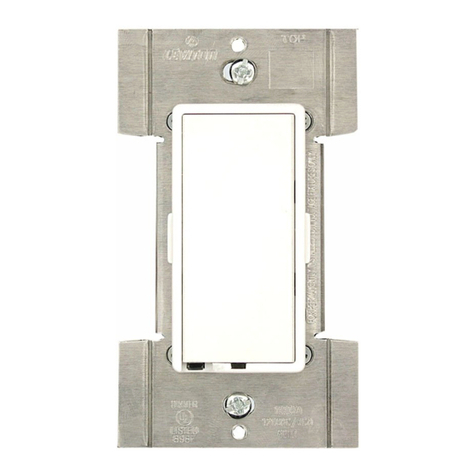
Leviton
Leviton Decora True Touch TTM10-1 installation instructions

LEGRAND
LEGRAND radiant WNRL50 quick start guide
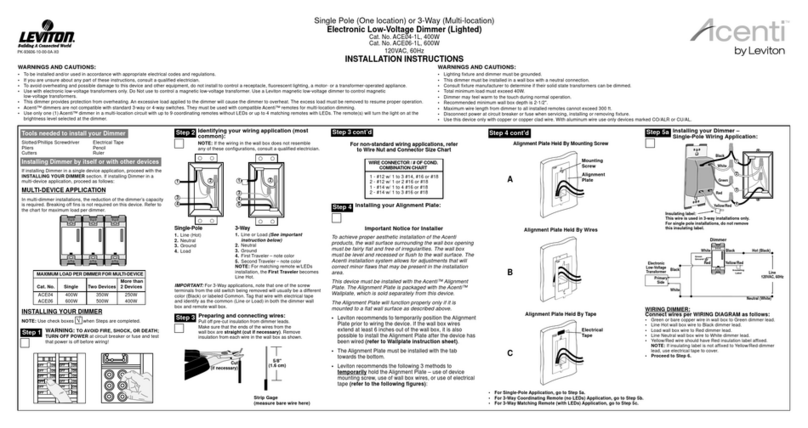
Leviton
Leviton Acenti ACE04-1L installation instructions
